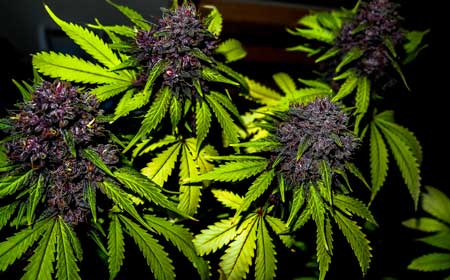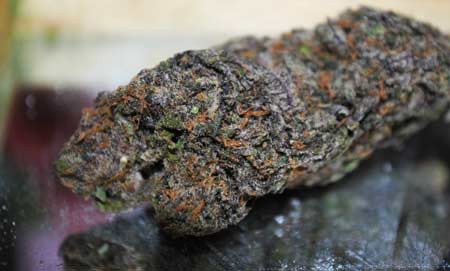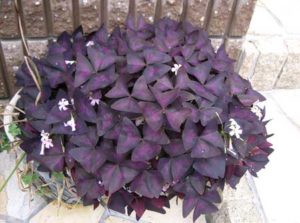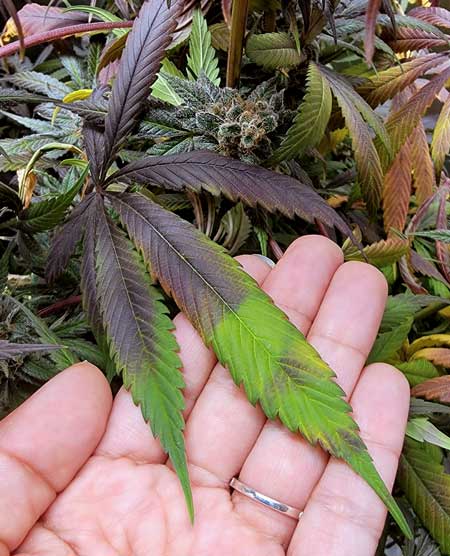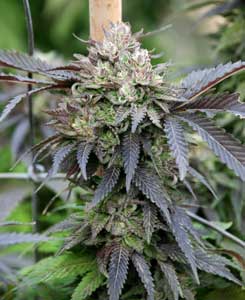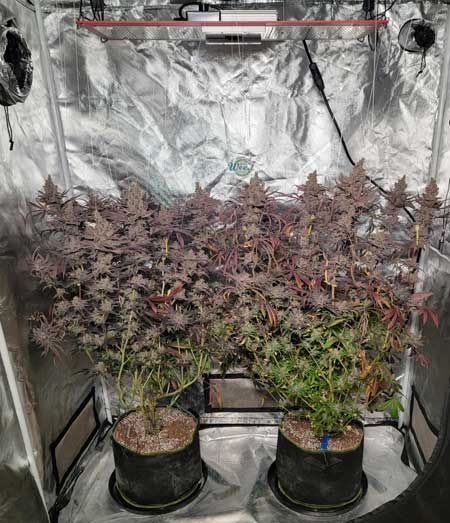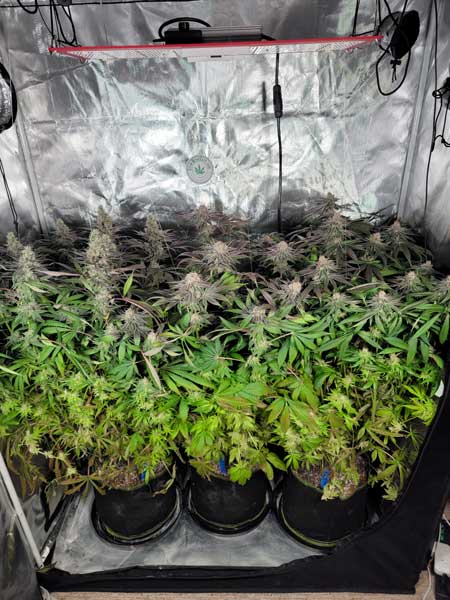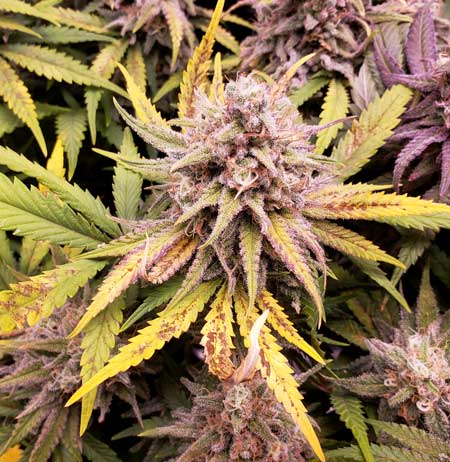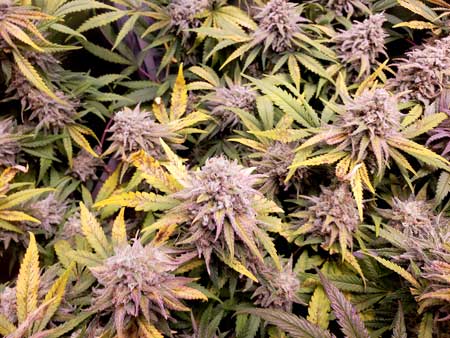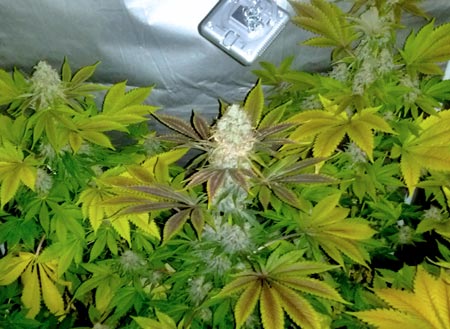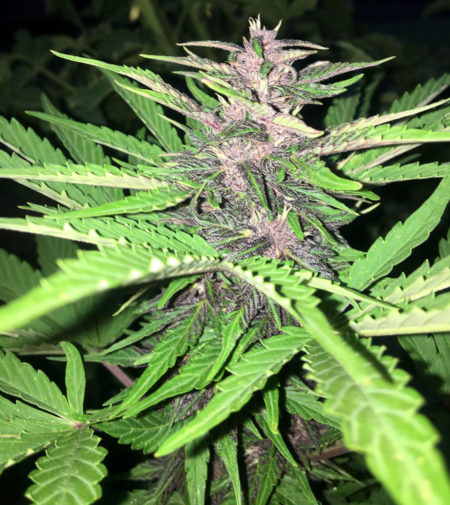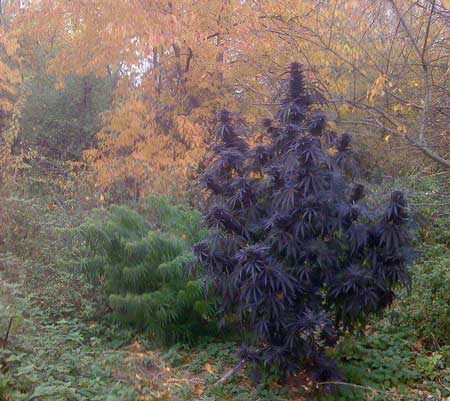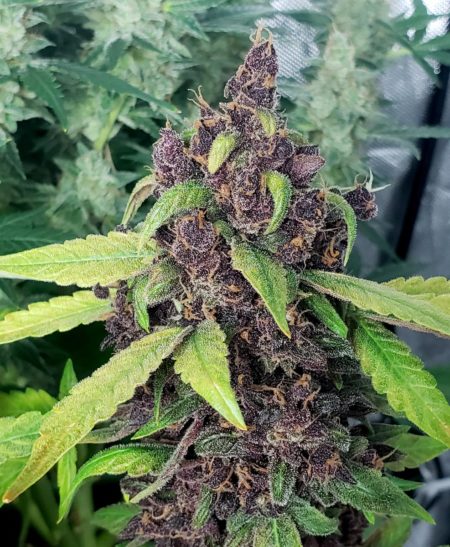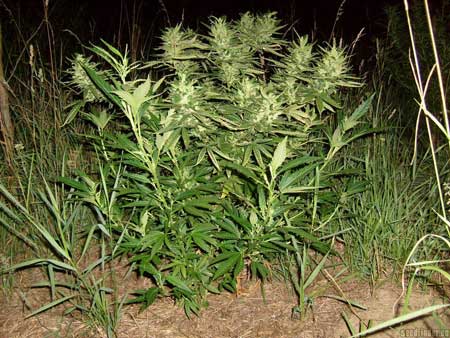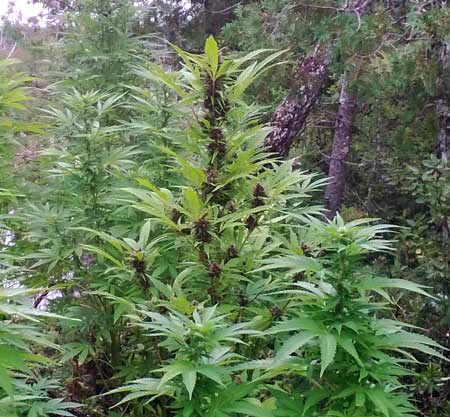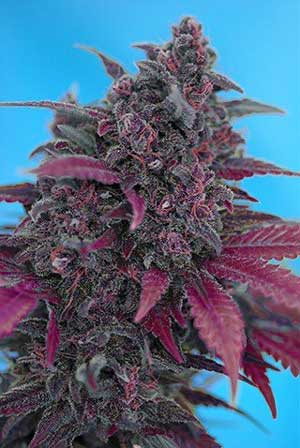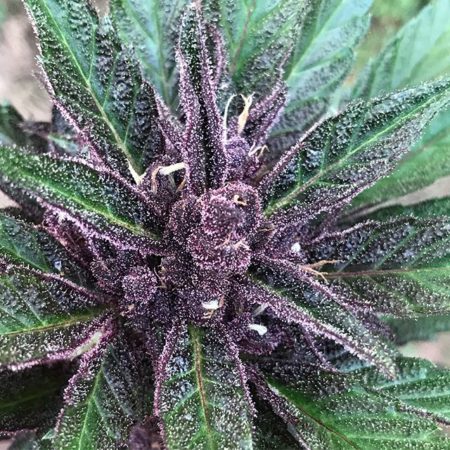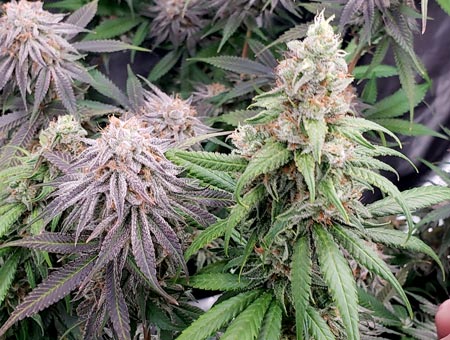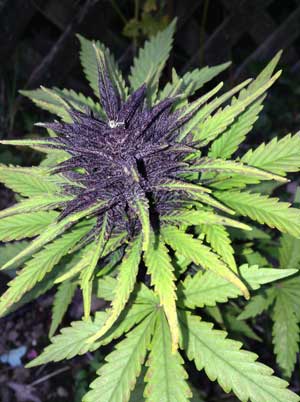By Nebula Haze
When I started growing cannabis, I was fascinated by the different colors of buds. The first time I grew deep purple buds, they looked almost too beautiful to be real. But is it a “good thing” to see purple cannabis buds? The answer may surprise you. Find out today!
All cannabis buds are flowers, but the purple ones look the part.
Deep purple buds are eye-catching, but what does it mean?
What makes cannabis buds purple?
Purple is the result of a pigment called anthocyanin. Anthocyanin causes the red, blue, and purple color in many plants, fruits, and vegetables.
Anthocyanin is found in many plants besides cannabis, such as this purple shamrock, or familiar foods like blueberries, eggplant, and red cabbage.
Anthocyanin acts as a “sun tan” in plants, protecting the plant’s cells from high levels of UV radiation. That’s why cannabis buds and leaves close to the light tend to turn purple, while shadier parts of the plant tend to stay green.
The parts of this leaf that turned purple were exposed to the light, while the green parts were hidden in the shadow of other leaves. The purple is essentially a “tan” to protect the plant.
Anthocyanin also offers protection against extreme temperatures, which is why cannabis leaves may turn purple in response to cold, temperature fluctuations, or other marijuana plant stress.
Cold or extreme temperatures can also bring out the purple. For example, the leaves on this outdoor cannabis plant turned purple overnight after the temperatures dropped close to freezing.
Does purple mean higher THC? It depends…
If the top of the plant is turning purple in the flowering stage even though it’s not cold, that’s a great sign because it shows the top buds are getting high levels of light. High light levels are associated with higher THC in buds, which means buds with a purple tint may contain higher levels of THC than the green buds on the same plant. If you see this purpling in normal temperatures, without nutrient deficiencies, it is a sign you’re giving the plant plenty of light, which is a good thing.
It’s a good sign if all the purple parts are getting direct light. Why?
- High light levels can cause purpling
- Buds that get a lot of light tend to produce more THC
That means you’re maximizing THC if the purple is being caused by high light levels (though not if the purple is being caused by nutrient deficiencies, cold, or other stress)
It’s often a good sign when the tops of healthy plants turn purple late in the flowering stage. This shows the buds at the top got intense light levels, which is associated with higher THC.
If most of the plant is staying green but the very tops of the buds are turning purple, that’s a sign that light may not be getting down deep into the plant. This may be a sign the plants are overly leafy like the ones below (which would benefit by being defoliated). In defoliation tests of cannabis plants in the flowering stage, removing leaves that hide buds from the light seems to increase yields, bud structure and potency of buds.
When there is just a little purple but most of the plant is staying green, it’s a sign that light isn’t getting deep into the plant. This plant was so leafy the light only reached the top of the plant. After harvest, the purple buds tested at higher THC than the light-deprived green buds.
When purple might actually be a sign of lower THC…
There are some cases when purple may signal lower THC. Here are 3 case examples:
First case: Nutrient Deficiencies
Nutrient deficiencies may cause leaves or buds to turn pink or purple, but this type of “purpling” is actually associated with lower overall THC levels. If the plant is turning purple because it’s not getting the proper amount of nutrients, the plant is not able to photosynthesize as much as it could, and the result is often lower bud potency (and yields).
If the purple buds are surrounded by unhealthy leaves that are curling, yellow, and/or have brown markings, you likely are seeing purple as the result of a nutrient deficiency. Not good.
In a healthy cannabis plant, you shouldn’t see a lot of sick leaves or brown markings on your leaves while buds are developing. Especially if you’re still several weeks from harvest. This plant started showing deficiencies after it used up all the nutrients in the soil early in the flowering stage. You can see it isn’t getting the nutrients it needs to keep leaves healthy and working hard. The resulting buds (while purple) likely won’t be as big or as potent as they could have been.
Second Case: Stress from bud rot, bug infestation, extreme temperatures, etc.
Certain illnesses, infections, or problems can cause parts of the plant to turn purple. For example bud rot, a bug infestation, and exposure to cold or extreme temperature changes.
These leaves turned purple because of bud rot, which means there is mold growing in the center of the affected bud (common with very thick buds). Buds affected by bud rot are not safe to smoke and should be thrown away.
Third Case: Certain Ultra-Purple Genetics
Plants that always turn purple from the beginning may have lower THC. This may possibly be because the “tan” of the purple is preventing the plant from getting as might light as it could have.
For some strains, buds appear purple from the beginning, and never go through a “green stage”
Some strains have so much purple in their genes that the entire cannabis plant turns purple from top to bottom. These strains often aren’t as potent as their sister genetics that stay green (though there are exceptions).
If the genetics are exactly the same except for the anthocyanin levels, it seems like the green buds may end up producing higher levels of THC (possibly because they don’t have a “tan” protecting them from the light).
What is the evidence for this? Some strains have different “phenotypes” and produce purple buds only sometimes. For example, the original Frisian Dew strain would sometimes produce plants with all green buds, while other plants would produce only bright purple buds that were never green. The breeders noticed that the plants with green buds tended to be more potent in lab tests.
Breeders noticed that their Frisian Dew plants which only made green buds tended to have higher potency
The Frisian Dew plants with purple buds may look prettier, but the buds may not be as potent even when grown in the same environment. That’s why when Dutch Passion developed an auto-flowering version of Frisian Dew, they chose to create the line with a green phenotype of Frisian Dew instead of a purple one.
Don’t worry, you don’t have to make a choice between purple and potent. Even purple strains can be very high THC when the genetics have been bred to have high THC. Let’s take a look at that next.
Two Best Ways to Grow Purple Buds
Do you grow your own purple buds? Here’s how to get the color and potency you’re looking for.
1.) Most Consistent Purple: Strain where buds never go through a green stage (may not be as potent)
Recommended photoperiod (standard) strains
- Grizzly Purple Kush – Sweet smell, strong potency but relaxing
- Purple #1 – Easy to grow with pleasing smell and effects
- Purple Kush – Purple and sticky, feels calming
Recommended autoflowering strains
- Auto Blackberry Kush – Easy to grow with great bud quality, smell, and bag appeal
- Auto LSD-25 – One of the most potent fully purple auto-flowering strains I’ve encountered
- Auto Mendo Mass – Stunning purple color and smooth strong effects
I’ve noticed that strains that are purple from the beginning often stay smaller and produce smaller yields than green buds in the same grow space. But not always.
2.) Get the Highest THC in Purple Buds
Follow these guidelines to grow high-potency purple cannabis buds.
- Use strong lights, especially LEDs (which are known for causing purpling)
- Get strains that are tested and shown to be high THC, which includes some purple strains
- Typically these strains start with green buds and only turn purple as harvest approaches
Recommended photoperiod strains
- Crystal Gelato – Super sparkly, excellent potency, buds often turn purple
- Fire OG Kush – “Fire” is a great way to describe the potency of this purple-tinted strain
- Girl Scout Cookies – A potent purplish version of the legendary photoperiod strain
- Platinum Cookies – Turns purple when given high light intensity, high THC (when I grew this strain, all the buds lab-tested at 25-27% THC), amazing effects/potency. The only downside is the buds take a little longer to mature. A crowd favorite. Read my full review.
- Purple Punch – I’m growing one of these plants right now. Tends to turn purple and buds test at up to 25% THC.
Note: I’ve noticed that most modern American genetics turn purple under high light levels when grown under LEDs.
Recommended autoflowering strains
- Auto Girl Scout Cookies – Auto-flowering version of the famous strain that grows with purple hints.
- Auto OG Kush – Potent for an auto-flowering strain and tends to turn purple close to harvest.
- Auto Cinderella Jack – A potent strain that’s easy to grow with dense buds and good yields. When I’ve grown this under LEDs, the tops often turn purple.
In this case, the purple and green strains were grown in the exact same environment. The green buds were old European genetics and the purple buds were new American genetics. After harvest, the purple buds tested almost 10% higher THC at the lab. This shows that you can’t rely on color to determine potency. Genetics is what matters the most!
Conclusion: Choose strains for effects first, color after
In my opinion, pretty colors are nice, but the most important thing when choosing a cannabis strain is that you like the effects it produces. So I recommend when shopping for genetics to choose strains for their effects as opposed to their appearance. That being said, high THC isn’t the most important thing to everyone, and many strains have unique effects even if they’re lower in THC. THC is definitely not the only thing to pay attention to when researching strains, either.
Often the highest THC buds are green, but some purple strains are an exception. One thing is certain: purple buds are downright gorgeous and certainly have that wow factor!
So there you have it, fellow growers. The mystery of purple buds, solved. Remember, whether your buds are green, purple, or somewhere in between, the most important thing is that you enjoy growing and consuming them. Happy growing!
About Nebula Haze
Nebula Haze is a cannabis growing enthusiast with a passion for teaching others how to cultivate their own weed at home. Sign up for her weekly growing newsletter to get articles like this delivered to your inbox every Sunday at 4:20 am!

